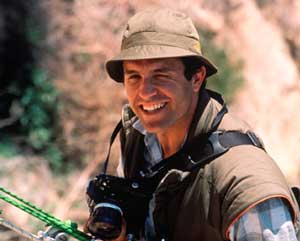Now in its 45th year, the annual Wildlife Photographer of the Year competition is very much the Oscars equivalent within the world of wildlife photography and, as such, has always attracted huge numbers of entries from amateur and professional photographers keen to showcase their work.
Co-owned by the Natural History Museum and BBC Wildlife magazine, this year the competition was sponsored by waste management organisation Veolia Environment and received over 43,000 entries from 96 countries. So how did the judges pick their winners? According to Mark Carwardine, chair of the judging panel, there is no such thing as a ‘magic formula’ for winning, although there is one special quality all the judges looked for: ‘While there are no hard and fast rules to explain why one photograph wins and another doesn’t, all of the winning shots have one thing in common – originality,’ he explained.
‘The competition plays an increasingly crucial role in raising the profile of wildlife photography and generating awareness of conservation. Nothing speaks louder than an evocative photograph that stirs the imagination, tugs at the heartstrings and engages the mind,’ he added.
If our selection of winning entries whets your appetite then get yourself along to the Natural History Museum, where all of the winning and highly commended entries are currently being exhibited. For more information or to book tickets, go to the Natural History Museum’s website at: www.nhm.ac.uk and follow the links to the WPOTY home page.
José Luis Rodríguez, Spain
Animal Portraits – Winner with ‘The Storybook Wolf’
When José Luis realised he had got the shot of his dreams – one that he had even sketched on paper – he couldn’t quite believe it. From the start, his fear had been that the wolves would be too wary. Iberian wolves have always been persecuted by people who see them as a threat to game and livestock (which they hunt when natural food is scarce) but also because of ignorance and superstition about the supposed danger they pose. Even though they have always lived close to humans, there are no verified incidences of them attacking people. In Spain, the population of Iberian wolves – a subspecies of the grey wolf – is thought to number 1,000-2,000 in the north, with a few tiny, isolated populations in the south. José Luis risked a slow shutter-speed to reveal the moonlit sky and conjure up the atmosphere of the place. He switched from using his Nikon D2X to a Hasselblad so he could get the exact framing that he had in mind. What José Luis hopes is that his picture, ‘showing the wolf’s great agility and strength’, will become an image that can be used to show just how beautiful the Iberian wolf is and how the Spanish can be proud to have such an emblematic animal.
Shot Info (top) – Hasselblad 503CW with a 6×6 Fujichrome backing, Planar 80mm lens; 1/30 sec at f/11, ISO 50. Shutter release triggered via a purpose-made Ficap infrared camera trap.
Award winning image disqualified – read story





